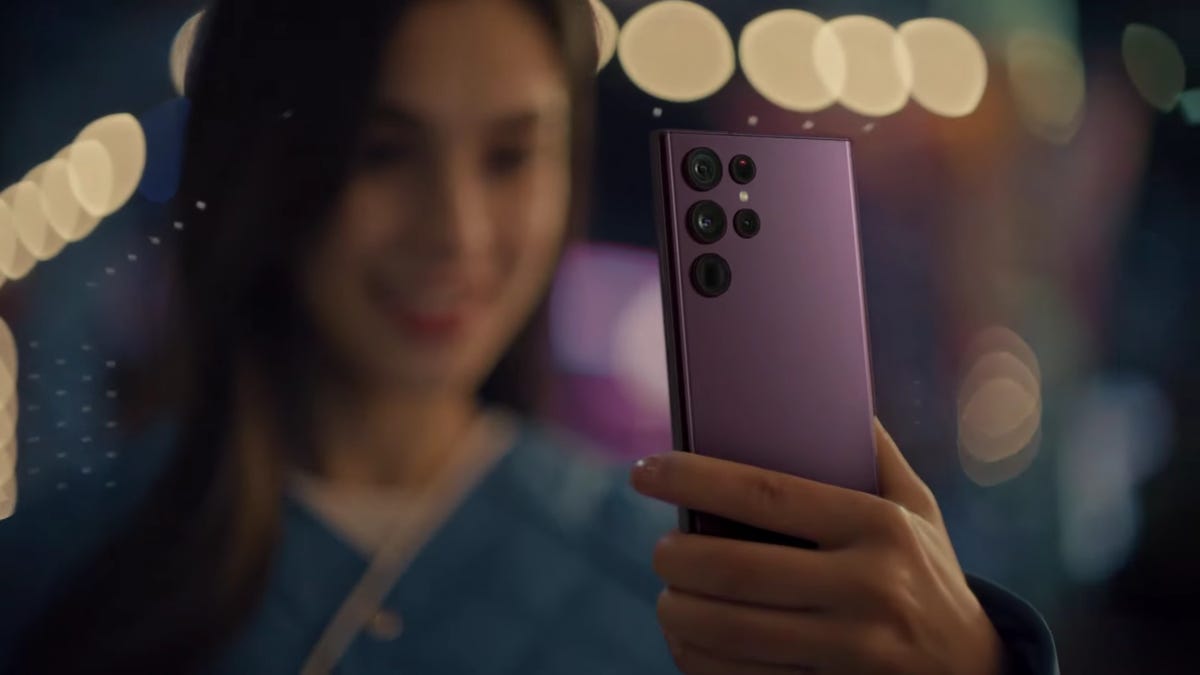Why the Galaxy S22 is so important to our freedom of phone choice
Samsung keeps losing market share in high-priced phones to Apple, which ultimately will hurt consumers.

The new Galaxy S22 Ultra is Samsung's priciest phone at $1,200.
The stakes are higher than ever for Samsung's Galaxy phones. The new Galaxy S22 and its siblings are its most advanced flagship devices ever, but the company's slice of the premium phone market continues to shrink. If Apple's growing dominance of expensive handsets goes unchecked, brands could back out, leaving consumers with fewer options when buying top-tier phones.
You're already starting to see this trend. Samsung's global market share for phones priced at $800 or more has dropped by a third over the last two years, from 28% in 2019 to 18% as of the third quarter of 2021. During the same period, according to analyst firm IDC, Apple's share has grown from 63% to 72%.
A slide from an IDC presentation showing the change in percentage of the premium smartphone market from 2019 through 2021 (first quarter through third quarter).
When one brand dominates, others shed their poor performers and consumers end up with fewer choices. The smartphone industry is littered with brands like Motorola and LG that have pulled back from the flagship phone market in the face of Apple's dominance. Even the retirement of the Galaxy Note line has left phone fans dismayed as Samsung tries new tactics to keep its top-tier phones competitive.
One big reason Apple is winning: its gains in the huge Chinese market, capitalizing on Samsung's absence to the point where just over one out of every five iPhones are sold in China, per IDC. But elsewhere, it's not obvious why Apple is winning. The phones made by both companies have sparkling specs, features and cameras. And if any brand has the edge with exclusive perks, it's the Galaxy S22 family's Space Zoom or the S22 Ultra's S Pen stylus.
A customer preference for iOS over Android isn't a likely reason either, as that would conflict with the fact that Samsung is the leader in smartphone shipments overall with a share of 20% of the worldwide market. If you're shopping for a phone less than $800, you'll likely buy one in Samsung's lineup.
In its push for global dominance, Samsung is running two races at the same time. It is pitting the A-series against midrange and budget phones released by Oppo, Xiaomi and other Chinese brands, and it is lining up the S-series and Z-series against Apple flagships. Currently, though, Samsung is only winning one of the races, and it's not one that brings in profits.
A graph from IDC's research showing how each brand's total of phones shipped in the third quarter of 2021 is split among price bands.
Samsung isn't competing against Samsung
One thing Samsung has avoided is tripping over itself. With the A-series phones integrating more flagship features and cameras at lower prices, it might appear that buyers are picking them over the premium (and pricier) S-series.
That's not the case, says IDC analyst Nabila Popal. Rather, the customers paying $800 and up for S-series phones and those paying no more than $600 for A-series are distinct groups.
"I don't think the A-series is cannibalizing the S-series," Popal said. "The S-series and A-series cater to different consumer segments."
In a briefing with CNET, a Samsung spokesman said the differences start with how people purchase their phones. S-series buyers in the US purchase their phones through carriers, while A-series customers get them from retailers like Best Buy or Walmart.
The A-series also appeals to buyers who want to compare phones from different brands to find the best value. Years ago, Samsung consolidated its midrange and budget lineup into the A-series, which Popal considers a smart move in light of Chinese competitors.
"I believe the A-series, which are roughly 70% of all Samsung shipments, kind of saved Samsung from the high competition they were facing from the Chinese players in the low to midrange segment, and helped maintain Samsung as a global leader in volume," she said.
But as much as Samsung wants to keep winning this race, it's premium phones like the S series that bring in profits.
"The S series is now a profit generator for Samsung while the A series is the volume generator and protects Samsung's global market share," Tom Kang, Research Director at the analyst firm Counterpoint Research, said in an email.
The Galaxy S22 range: taking on Apple alone?
Samsung has taken some gambles to claw back its share of the premium market from Apple. It effectively shuttered the beloved Galaxy Note line, integrating its stylus capability in the priciest Samsung Galaxy S22 Ultra and Samsung Galaxy Z Fold 3 handsets.
It's also betting on foldable phones, with the best devices in that segment and a lead on most other phone makers in developing dependable foldable designs at scale. Consumers, though, aren't embracing them just yet. Sales of the Z-series account for nearly 8 million of the 9 million foldables sold globally in 2021, but they make up just a sliver of the 270 million phones Samsung shipped in 2021.
With no other flagship phones on the horizon (for now), like a new Galaxy Note, Samsung is depending on the Samsung Galaxy S22 range alone to win more of the premium phone market. And given the lack of competition among other brands, Samsung's top-tier phones are the only Android phones challenging Apple for premium dominance.
Outside of choosy customers, Samsung's S22 phones will face other obstacles to win market share in 2022. The chip shortage is still raging, impacting everything from phones to cars to refrigerators, and analysts suggest components scarcity and supply chain impediments could still slow phone shipments.
Of course then there's Apple. Later this year, it's expected to launch the iPhone 14, giving the S22 more competition. Samsung's two-front war continues on.

